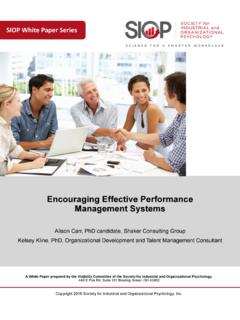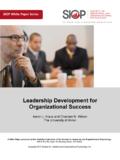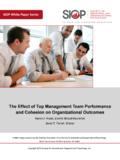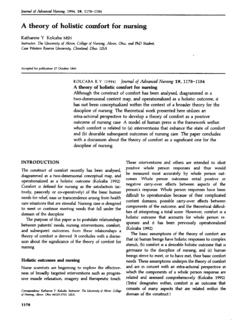Transcription of Work Life Balance - Welcome to SIOP
1 work - life Balance Alison A. Rife, , Booz Allen Hamilton Rosalie J. Hall, , Durham University SIOP White Paper Series A White Paper prepared by the Visibility Committee of the Society for Industrial and Organizational Psychology. 440 E Poe Rd, Suite 101 Bowling Green, OH 43402 Copyright 2015 Society for Industrial and Organizational Psychology, Inc. 2 SIOP White Paper Series Table of Contents Authors .. 3 Abstract .. 4 Introduction .. 4 Background .. 5 Implications for Practice .. 7 Next Steps .. 8 References .. 10 3 SIOP White Paper Series Authors Alison A. Rife Booz Allen Hamilton Ali Rife, Booz Allen Hamilton, Ali Rife, works as a consultant for Booz Allen Hamilton. She recently graduated from the University of Akron, earning her doctoral degree in Industrial-Organizational Psychology.
2 Ali enjoyed working under the advisement of Dr. James Diefendorff, research-ing topics of work motivation, emotional labor, and occupational health and em-ployee well-being. Currently, she and her husband reside in the Charlotte, North Carolina area. Rosalie J. Hall Durham University Rosalie J. Hall, , is currently a Professor at the Business School at Durham University in northeastern England. She received her degree in Industrial-Organizational Psychology from the University of Maryland in 1988, following which she taught in Industrial/Organizational Psychology program at the University of Akron for 25 years. Her research and applied inter-ests are in organizational behavior (with emphasis on the perceptions of leaders and followers in the organizational context), research methodology and statistics.
3 4 SIOP White Paper Series Abstract work - life Balance signifies the extent to which an employee experiences feeling fulfilled and having his or her needs met in both work and non- work facets of life . Through experiencing greater work - life Balance , individuals report feeling better in general ( , greater job and life satisfaction) and tend to behave in favorable ways ( , lower turnover and absenteeism). Historically, the influx of women in the workplace jumpstarted research into how female employees could successfully care for families while working, but today work - life Balance is dis-cussed with respect to multiple affected groups ( , men, single parents). In the modern era of technology and convenience, organizations have begun to provide their employees with helpful ways to Balance their work and non- work roles through benefits like flexible work hours, telecommuting, and so on.
4 How-ever, offering these benefits is not enough; the organization and management must stand behind its promotion of healthy work - life Balance for employees by creating a culture as such and designing policies that support this initiative. Oth-erwise, employees feel pressure to continuously work , which can be perpetuat-ed by mobile devices and constant accessibility of the internet that allows em-ployees to transport a workstation wherever they go. Results indicate that in general many people report experiencing poor work - life Balance but not for lack of wanting it; therefore, employers and employees alike should consider what is most important for achieving this healthy Balance . Implications and next steps for practitioners are discussed.
5 Introduction Employees with work - life Balance feel their lives are fulfilled both inside and outside of work (Byrne, 2005), and they experience minimal conflict between work and non- work roles. Those who achieve this Balance tend to have higher levels of satisfaction with their jobs and life in general, as well as lower levels of stress and depression. From an employer s viewpoint, encouraging work - life Balance may attract new hires, help re-duce turnover and absenteeism, and increase the chances of employees voluntarily engaging in pro-social behaviors that rise above and beyond their job requirements. Nevertheless, findings are mixed with respect to effects of employee work - life Balance on the company s bottom line. For example, having family-friendly work policies, when a firm uses good management practices overall, does not detract from profitability, but may not always increase profits.
6 In sum, evidence suggests a work strategy of running yourself ragged has costs both for meeting performance goals and enjoying 5 SIOP White Paper Series life ; the employee and the organization benefit most when workers experience great-er Balance between what they do on and off the clock. Background Original concerns with work -family conflict more recently have broadened to consider work - life Balance /spillover. In this newer perspective, multiple work and life (not just family!) roles are viewed as potentially benefitting, as well as harming, one another. When role conflicts do occur, they can involve time, effort, resources, behavior, and/or affect, and they may originate both from work -to-family and family-to- work , with different causes identified for each direction (Mesmer-Magnus & Viswesvaran, 2005).
7 Experiencing either form of conflict causes employees psychological distress and lower job performance and, since individuals have a limited supply of time and ener-gy resources, something has to give when multiple roles exhaust the person of time and effort. Finally, although traditional thinking about work - life Balance has tended to emphasize its relevance for women with children, there is increasing consideration of its importance for men, and for singles or couples without children. Historically, several important pieces of legislation ( , Civil Rights Act of 1964, Pregnancy Discrimination Act, Family Medical Leave Act) helped women to obtain work , and, as women often had primary caretaking responsibilities for families, pro-moted work - life Balance initiatives as well.
8 However, even given legislative stand-ards, research shows that employees tend to feel comfortable attending to their non- work -related needs ( , by taking family- or health-related leave that they are legal-ly entitled to) only when organizational policies, cultural norms, supervisors, and sur-rounding coworkers also demonstrate a commitment to work - life Balance (see, for example, Kossek, Baltes, & Matthews, 2011). In other words, organizational support is critical to promoting a healthy work - life Balance for employees. Although traditional thinking about work - life Balance has tended to emphasize its relevance for women with children, there is increasing consideration of its importance for men, and for singles or couples without children.
9 6 SIOP White Paper Series How can an organization support its employees? Doing so requires attention to the details of policies and practices related to: work hours and job design (restricted hours, minimal work required during off-hours) organizational culture ( , minimize negative norms such as No one leaves un-til 7pm ) incentives that encourage balancing work and non- work domains ( , take va-cation or the cash pay-out is less) work - life Balance policies frequently include benefits such as flexible work hours, child- and elder-care provisions, paid maternity leave, adoption assistance, leave/time off, education assistance, health assistance, and housing assistance. Flexible work hours, telecommuting, and job sharing also may encourage work - life Balance , and for some organizations may help reduce costs for non- work -related absences.
10 However, research clearly shows that regardless of what the organization promotes, direct supervisors/managers greatly influence the work - life Balance of their subordi-nates. Managers who focus on the desired work product, rather than requiring face time or logging overtime hours, can better enable their employees to Balance work and life demands. An important caveat to note: when organizations advertise a cul-ture of work - life Balance to job applicants but then fail to implement or enforce the policies, they may quickly lose those new hires. Also important to note, the menu of work - life Balance supports should be broad enough to meet the needs not only of parents with children, but also singles and childless couples. Modern technologies, providing constant accessibility to internet and mobile devices, can blur the boundaries between work and non- work .









